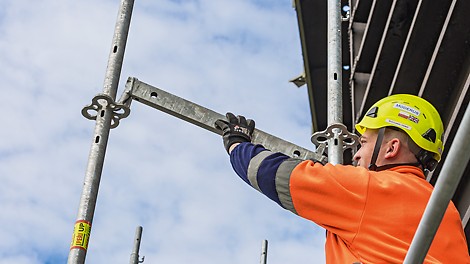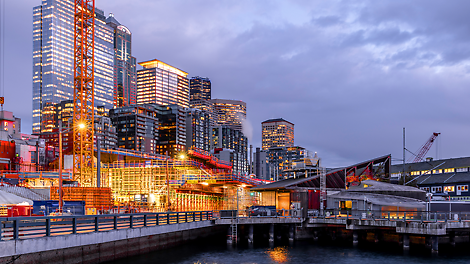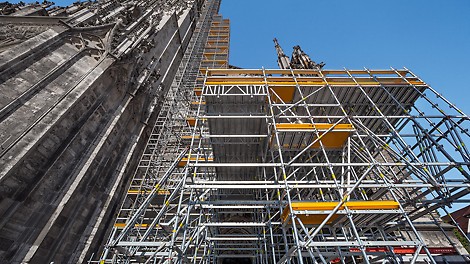
Throughout the world, safety requirements in the construction industry are becoming increasingly important. The multitude of applicable guidelines, regulations and requirements all have one thing in common: they all aim to make construction sites safer – irrespective of whether they are applicable worldwide, nin Europe or only in certain countries. All the same, the issue of safety should be of paramount importance to companies on account of their responsibility towards personnel, not simply because of the necessity to meet legal requirements. A high degree of safety is also a quality characteristic. It is advantageous to companies on several fronts: after all,promoting health and safety in the workplace also benefits the company from an economic point of view.
Safety is a topic that is relevant to all parties that are involved in the construction project and are present at the construction site. In Germany, for example, it is primarily the client who bears overall responsibility and can therefore be held jointly liable. However, architects, site managers and coordinators from companies working on the construction site may also be held liable for accidents.
So what are the specific measures that help to improve the level of safety on construction sites? It is important to have a comprehensive safety concept that takes a holistic approach to all phases of the project rather than focusing merely on a subsection of the construction process. This is where the PERI safety concept comes in. It consists of four elements that come together to provide an outstanding level of safety on the construction site: system, application, process and result. In addition, however, the costeffectiveness of the systems also has a significant role to play, meaning that the benefit to the customer is, in an ideal scenario, two-fold.
The PERI safety concept
Four pillars for your successSystem safety by means of intelligent design
PERI addresses the topic of safety as early as the development and design phases for its formwork and scaffolding systems. The safety technology used in PERI products is often built into the system itself. Numerous smart features of the PERI UP Scaffolding System can improve both the degree of safety and the economic efficiency for a wide range of scaffolding applications - from facade scaffolding to shoring and reinforcement scaffolding on the construction site. Safety is a particularly important area of focus when working at great heights. The Ulm Minster restoration project exemplifies this perfectly. Extensive PERI Scaffolding Solutions were installed on the highest church steeple in the world in order to carry out the renovation work on the vaulted ceiling, the choir stalls, the main tower and the 86-m-high choir tower.
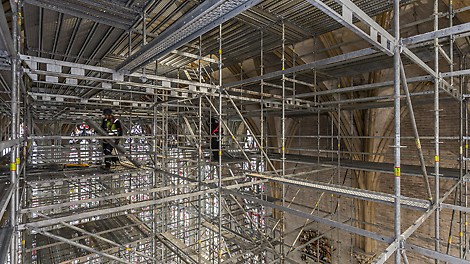


Application safety and reliability thanks to safeguarded assembly and working
In addition to the high quality of the systems and their innovative technology, the ability to use the systems safely is of significant importance. Put it this way: the simpler and more self-explanatory the assembly process and the subsequent application, the higher the degree of safety. For example, the fact that the PERI UP Scaffolding System could be adapted flexibly and easily to the given weight and geometry in 25-cm increments was of paramount importance when installing the scaffolding on the main tower of Ulm Minster. The grid allowed for an uninterrupted transition from the staircase to the scaffold bay, thereby creating trip-free working levels. This resulted in tiered working levels and access options that allowed work to be carried out safely on both the choir vault and the choir stalls at the same time. The yellow toe boards along the landings also prevented small objects from falling to the ground. The assembly process can also be carried out quickly and easily due to a low number of system components. If necessary, certain systems can even be delivered to the construction site in a fully assembled state, increasing the degree of application safety and reliability further still.
Process reliability due to optimal support at all phases of the project
Process reliability also plays a decisive role in ensuring that the construction process is straightforward. Due to the fact that its formwork and scaffold systems can be optimally combined, PERI is able to offer its clients a decisive advantage. Considering the fact that the PERI portfolio, with its various consultancy, engineering and project-related services, offers solutions for all phases of the project, PERI is able to provide a comprehensive support package whenever required.
By using Building Information Modelling (BIM), we can offer you real added value. BIM is a forward-thinking approach that can be used to plan and control all construction processes. All of the trades that are involved in the construction process work on the basis of a digital 3D model that has been developed with the aid of CAD software. In this way, even individual alterations made during the construction project are immediately visible to all parties. On the one hand, this increases the transparency of the project, but also improves the level of efficiency and ultimately leads to a greater degree of planning and cost reliability. Any planning errors and safety risks can be identified at an early stage and rectified in good time.
The BIM method was also used during the Ulm Minster refurbishment project. The PERI engineers’ on-site support during the Ulm Minster project ranged from 3D planning to tests for structural integrity. While the scaffolding for the main chamber could be planned in a conventional
manner, the process of surveying the sanctuary proved to be the biggest challenge that the engineers faced during the project: “We only had access tohistorical 2D as-built plans which made it impossible to plan the scaffolding for the complex geometry of the sanctuary,”
explains the project manager in charge, Lothar Stärk. Together with the Minster Site Office and the scaffolder, he came up with a concept that met all of the geometric and safety-related requirements pertaining to the high working level required for the restoration work.

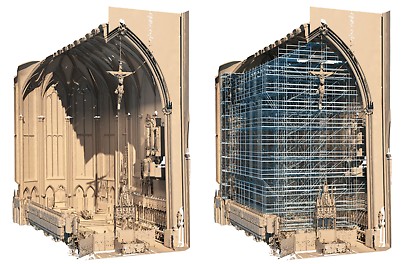

A 3D scan of the interior provided the basis for this. This made it possible to determine the dimensions and then translate them into a three-dimensional building model. Finally, Lothar Stärk worked out the complicated, three-dimensional geometry of the sanctuary’s interior with the numerous niches and curves in the vaulted ceiling and an overall size of 13,000 m³ using a free-standing, metric system grid in 25 cm and 50 cm steps. What was particularly challenging was the fact that no ties could be anchored to the historical building for fear of causing damage. The three-dimensional visualisation of the scaffolding also served as a common communication model and delivered real added value during meetings involving all project participants. It was possible to identify and quickly resolve clashes and conflicts of interest in an optimal manner.
Thanks to the BIM method used, not only did the scaffold planning process itself prove to be particularly efficient, but also the subsequent on-site assembly process. The client benefited from a high degree of planning reliability and from time savings throughout the entire construction process. The delivery of materials was also planned in consultation with the scaffolder and was carried out using a just-in-time approach on account of the spatial restrictions. The regional nature of PERI as a company proved to be extremely useful in this regard. The central location of the rental park for system units at PERI’s head office in Weissenhorn offered a short transport route to Ulm – and on-schedule supply of materials without any downtime. Sticking to the demanding schedule was straightforward.
Guaranteed results borne out of expertise
By viewing the construction process as a whole, losing sight of the outcome is not an issue. In this way, PERI is on hand to assist in an advisory capacity with their extensive expertise from an early stage when it comes to supporting architects and planners. Drawing on their international expertise, experienced PERI engineers can, on request, provide support over the course of an entire construction project and carry out structural preliminary planning work and feasibility studies. All of this contributes to the desired outcome – that taking this approach will mean that the objective can be achieved in a safe and efficient manner.
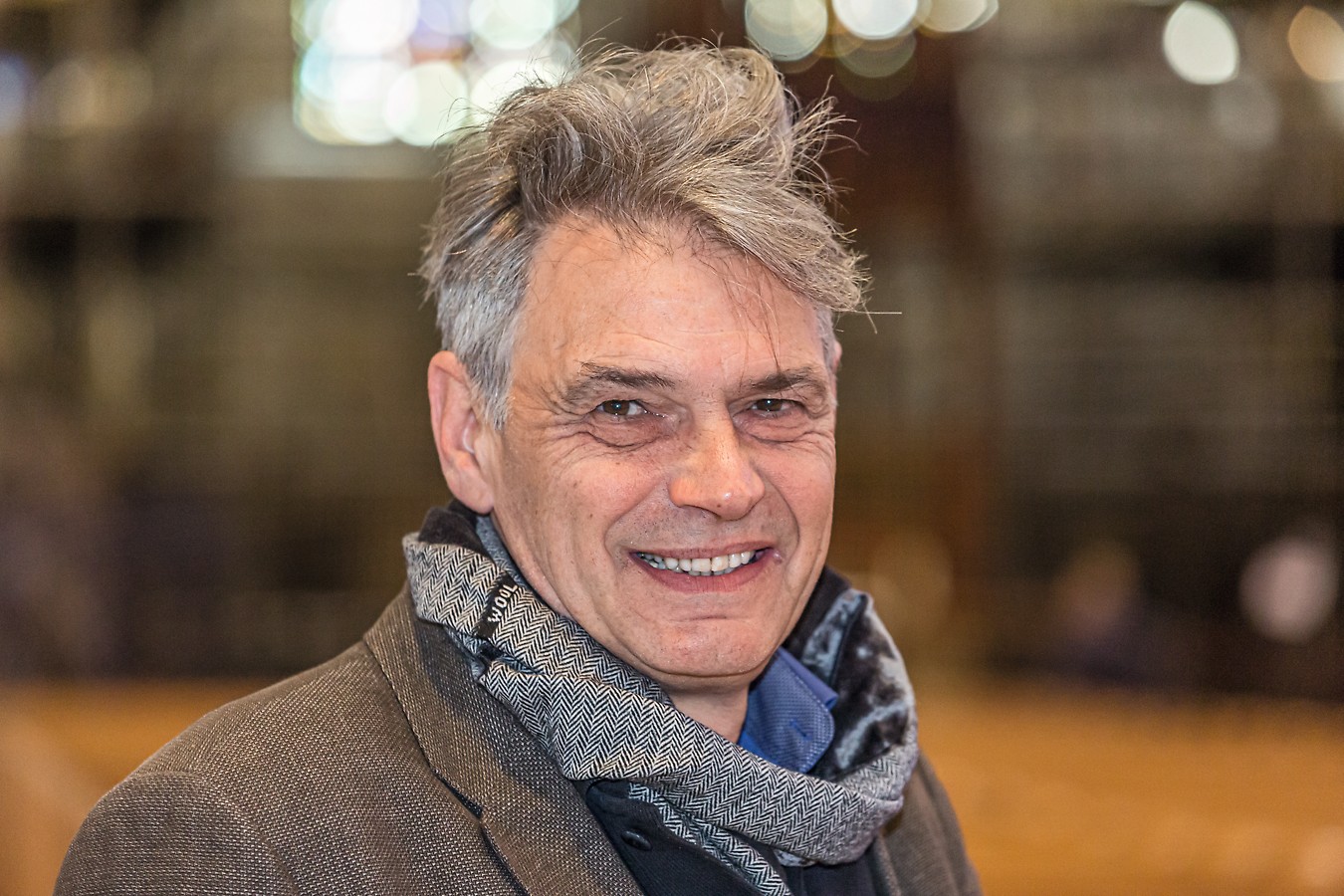

We are on site for you worldwide
Our support knows no borders - no matter where you are in the world. Simply select the website for your country and discover detailed information about our products, projects and contact details for our local contacts. We are always happy to assist you and look forward to helping you too.
